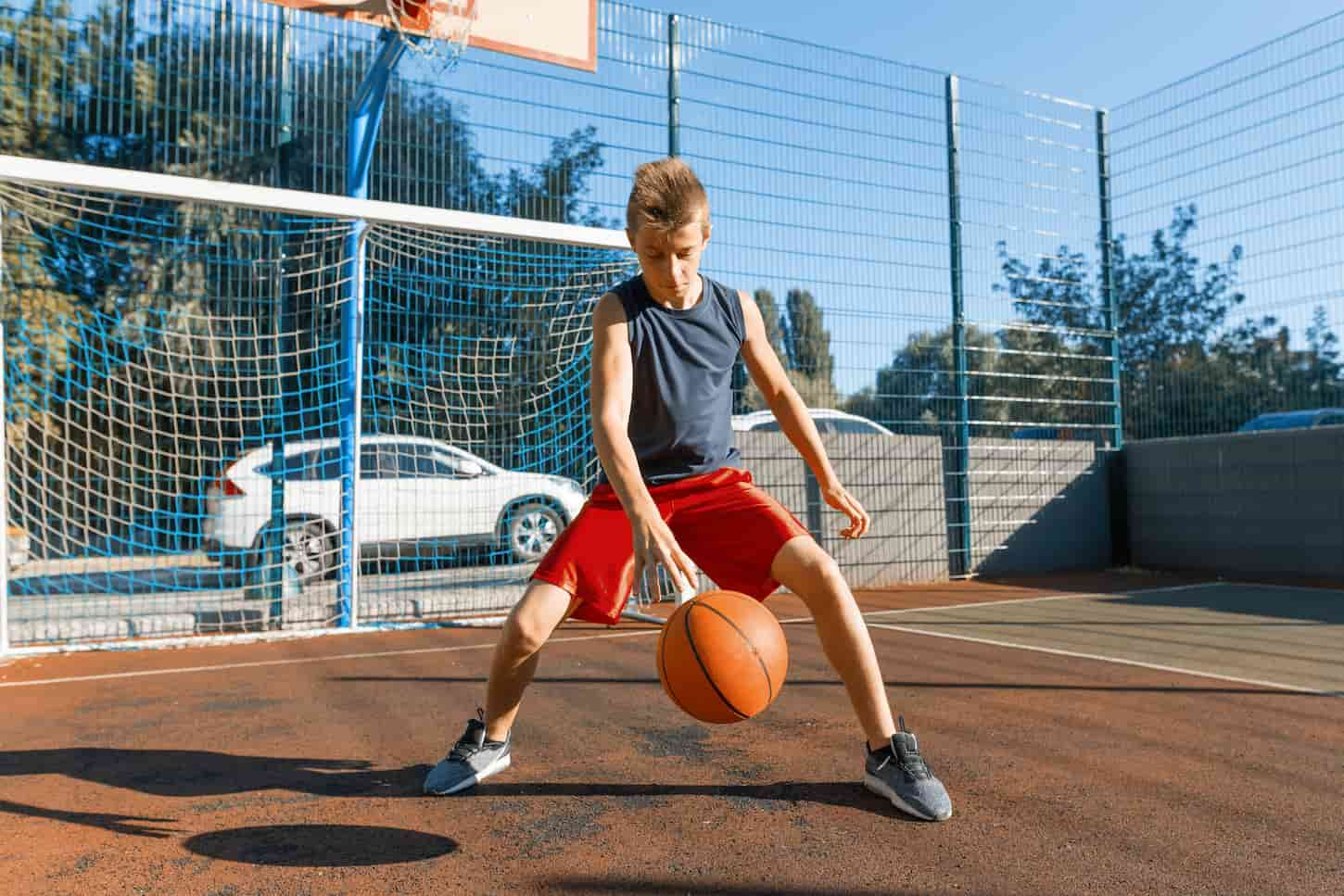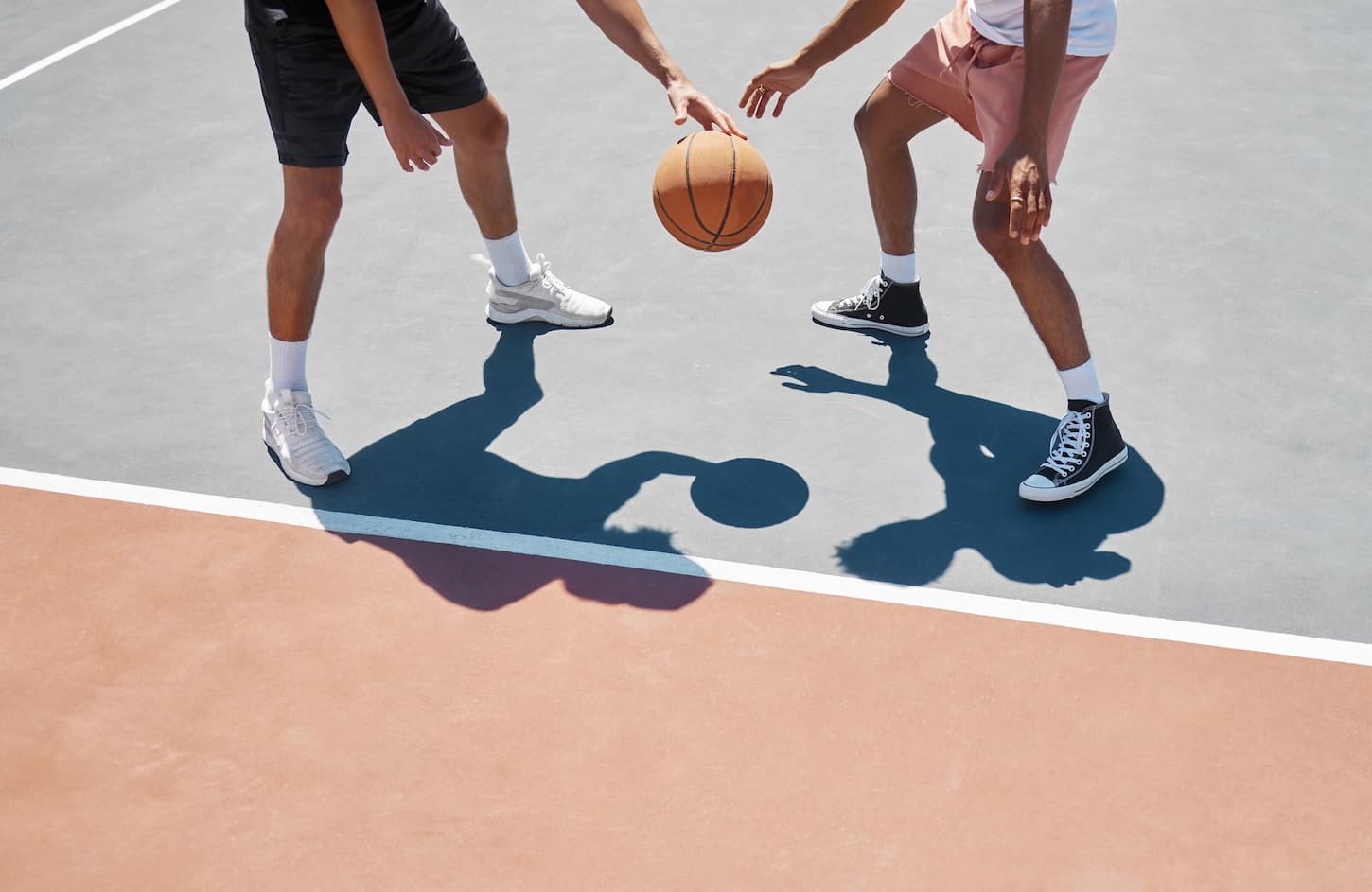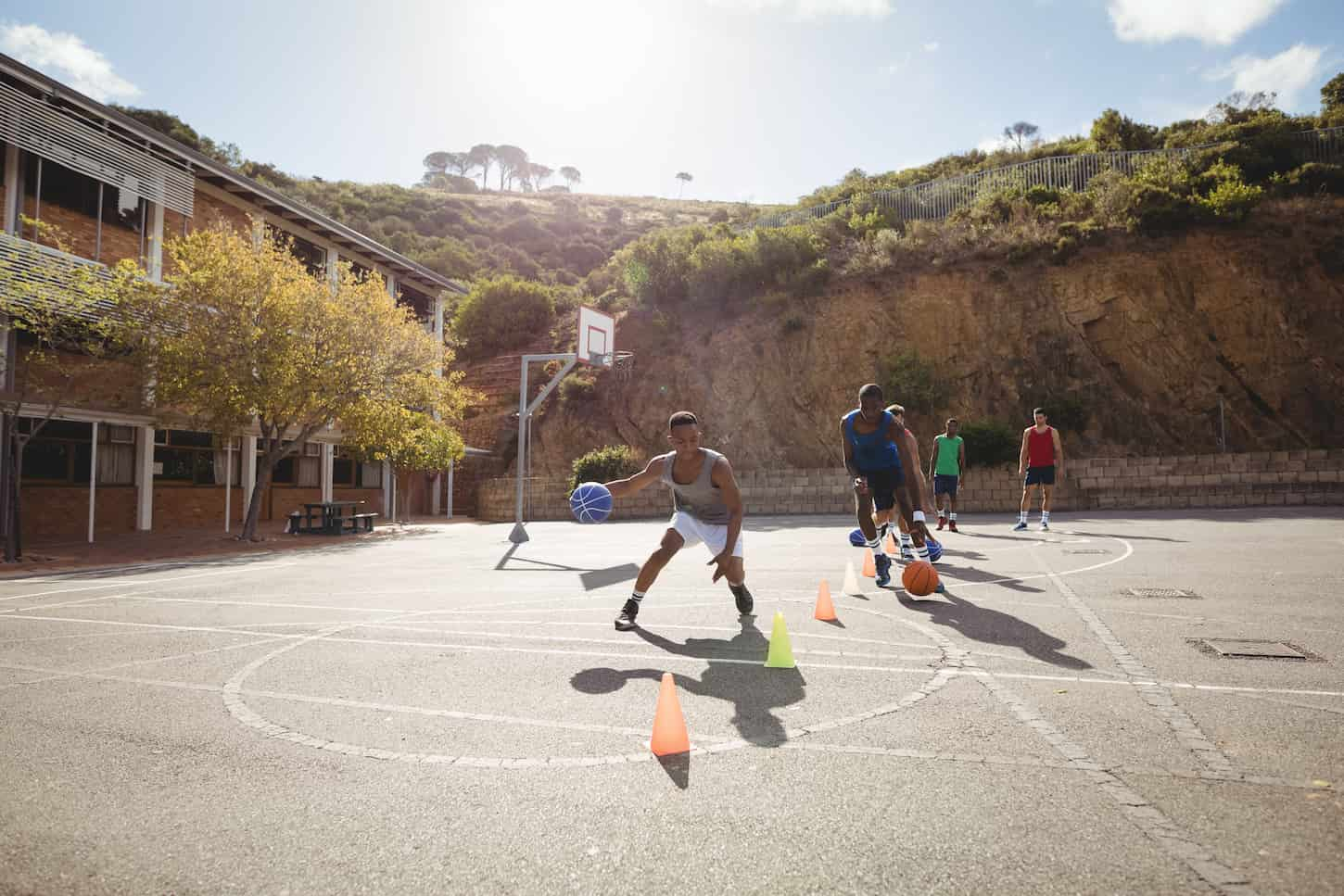Basketball is one of the most popular sports in the USA and is a fun and exciting way for kids to keep fit. It’s also a fantastic stress reliever and helps children with emotional, social, and cognitive development. If our kids love basketball, we might wonder what drills they can practice at home.
There are many drills kids can practice at home. Drills include weak hand skills and dribbling through cones. Passing drills include wall and partner passing, and the best ones for shooting include squat shooting and free throws.
With any sport, practice makes perfect, and doing drills at home makes children better and stronger players. But in youth basketball, it’s crucial not to get too serious because it could lead to burnout. If you want to know eight great basketball drills for kids to do at home and how to keep sessions fun and interesting, look at the crucial information below.

8 Basketball Drills Parents Can Do With Their Kids at Home
The easiest basketball drills to do at home with kids include wall passes and dribbling, for which they do not need a hoop. If there is a hoop – they can also practice shooting drills such as squat shooting.
Basic basketball drills for children under 10 years should focus on dribbling, shooting, and passing. After 10 years, they can include drills for a rebound, defense, and footwork.
If parents want to help their child develop basketball skills at home, we’ve listed 8 of the best basic youth basketball drills for kids below.
Dribbling drills
Dribbling is a crucial part of basketball because this is how players move the ball around the court. Dribbling helps children learn how to handle the ball and get used to the power of the rebound.
Encourage kids to dribble with their fingers spread out, which gives them more control. The ball should stay at hip height when they dribble, and they must keep their head up, looking ahead, and not at the ball.
Drill #1 – Improve weak hand dribbling
Weak-hand dribbling is when we get our kids to dribble the ball with their weak hands. When children can dribble with both hands, it makes them more versatile and improves their coordination.
With weak-hand dribbling, children should practice with their weak hands on the spot first. When they’re comfortable doing this, they can begin to move around with the ball.
Drill #2 – Practice straight-line dribbling
Straight-line dribbling is when children dribble in a straight line and swap the ball between their hands every two or three dribbles.
As they become confident dribbling in a straight line and passing the ball between their hands, they can incorporate more advanced things like dribbling behind the back and through the legs.
Drill #3 – Learn to dribble between cones
Cone dribbling is when we set up a line of cones for children to dribble around. They must weave through the cones with the ball, changing their hand as they go around each cone.
Encourage kids to stay low to the ground and maintain forward momentum. They should view the cone as a defender and pick up a faster pace as they become more confident.
Shooting drills
Shooting is a fantastic way to develop hand-to-eye coordination, and we should choose the ball and hoop size depending on the age group. Teach children to aim for the back of the ring and throw with their dominant hand while they aim with the other.
Drill #4 – Squat shooting
With squat shooting, children learn how to use the power of their legs for shooting. Incorporating the legs and lower body will make them better shooters. It’s a bad habit if they only rely on the power of their upper body.
Get kids to shoot close range from five places with a squat shooting drill. These should be the equivalent of a court’s corner, wing, top, and opposite corner and wing. Get them to exaggerate the squat and use the force of their legs for every shot.
Drill #5 – Practice free throws
Free throws are a fantastic way to build a child’s confidence and perfect their shooting technique. With a free throw drill, you get kids to take multiple shots from the free throw line.
You can start with ten shots per drill and gradually increase the number. Get them into the habit of not passing the line till the ball has sunk, as per competition rules. To make it more interesting, set challenges – like sinking 10 out of 20 shots.
Drill #6 – Play around the world
Around the world is when the player shoots short range from 5 spots around the court – corner, wing, top, wing, opposite corner. They must shoot and catch the ball from each spot – so it is a fantastic way to practice shooting from different angles.
The player starts from the corner and must shoot until they make a basket. When they sink a ball, they can move to the next spot until they return to the starting point.
Encourage kids to make the round in as few shots as possible and for an extra challenge, send them back to the starting spot if they miss a shot.
Passing drills
There are several types of passes, including bounce, overhead, and one-handed. When kids pass the ball, get them to keep their thumbs down, feet shoulder-width apart, and elbows out. They should also step into the pass. Kids can practice passing drills against a wall or with a partner.
Drill #7 – Wall passes (solo passing drill)
Kids can practice overhead and one-handed passes against a wall if they don’t have a partner. For the best results, they should be around 6 feet away from the wall and do 20 – 30 passes per drill or 5-10 for young children.
With wall passes, kids should face the wall with their feet spread shoulder-width apart. Ensure their fingers are spread wide on the ball and their knees are bent, and encourage them to extend their arms into the throw. We can draw a target on the wall to help them aim.
Drill #8 – Partner passing
Partner passing is when kids practice passing with a partner. This could be a sibling, a friend, a parent, or a caregiver. With partner passing, kids can practice all passes, including the chest and bounce pass.
For partner passing, players must stand about 6 feet apart. At first, they should pass the ball from a standstill. As they improve, we can increase the distance between them and get them to move around while they pass.
As they get more advanced – we can ask them to dribble between passes.

What are Some Fun Basketball Drills?
Children learn more when they have fun, and some fun basketball drills to try with kids include HORSE and Simon Says. Parents can also make regular drills more fun by setting challenges, such as how many passes they can make without dropping the ball.
HORSE is a shooting game for two or more players. The first person shoots from anywhere, and they can set challenges, such as shooting with closed eyes or standing on one leg. If they score, the next person must mirror their shot from the same place on the court.
If the first person doesn’t score, the next person decides where to take the shot and sets a challenge. When a player misses a shot, they get a letter H and so on – until they spell the word horse. At this point, they are out, and the winner is the remaining one on the court.
Simon Says is a fun drill that is particularly good for young children. It’s a take on the classic game, but instead, Simon gives them basketball commands. For example, Simon Says to dribble with your weak hand for 30 seconds.
What are Some Good Basketball Drills For Kids?
The best basketball drills for kids help them build skills in all areas – including shooting, passing, and dribbling. This includes drills such as weak hand dribbling, squat shooting, and partner passes. To keep spirits high, kids should also do fun drills regularly.
Below, let’s recap the best basketball drills for kids:
- Shooting Drills – Around the world, squat shooting, and free throws
- Dribbling Drills – Weak hand dribbling, cone dribbling, and straight-line dribbling
- Passing Drills – Wall passes and partner passes
- Fun Drills – HORSE and Simon Says
How Can a 10-Year-Old Get Better at Basketball?
Before ten years old, children must master basic basketball skills such as dribbling, passing, and shooting. After ten years old, we should incorporate footwork and defense drills and teach children how to use these skills against opponents.
At ten years old, children are ready for more of a challenge. We can increase their practice time from 30-60 minutes to 45-70 minutes twice a week. We can also get them to play with a larger (though still age-appropriate) ball and hoop – and raise the height of the hoop from the ground to the standard height for their age group.
Children can play competitive games from 8 to 10 years old, which helps them learn more about rules, strategy, and teamwork. It’s crucial to keep practice fun with a mix of fun games and drills. The aim is to slowly introduce competitive skills and strategies without being too rigid.
How Can I Make My Youth Basketball Practice Fun?
The best way to make youth basketball practice fun is by not taking it too seriously or putting kids under pressure. Keep the atmosphere happy and light and incorporate fun challenges into drills, such as who can dribble the longest with their weak hand.
Get feedback about the sessions, find out what kids like and don’t like, and take this into account for future sessions. Always end the practice on a high note and offer lots of praise and rewards for good practice.
Basketball has many positive benefits – it keeps children fit and healthy, helps their physical and cognitive development, and is a great stress reliever. If we take it too seriously, kids won’t get the benefits. In fact, the opposite could happen – they might get burnout.

Best products for kids’ basketball
Practicing basketball drills (whether at home, at team practices, or with friends) goes best when you have the right gear.
Best at-home hoops to practice
- Best hoop: This Lifetime basketball hoop was first introduced to us at our kids’ summer Champ Camp, where they learned all sorts of sports, including basketball. Our kids still play with it, and while it’s not the full height, it’s a great practice hoop for kids who don’t play at the whole regulation hoop height. In our experience, it’s great for any kid over the age of 5 and up to about 12. It’s also perfect for less competitive pickup games at home. Once your child gets into more competitive games with a standard-sized ball, they’ll want a standard hoop.
- Good hoop: This option is a great middle-level basketball hoop, stretching from about 3 feet up to over 6 feet tall. If you start with this hoop, it could be a good way just to have one practice hoop until your kids are 10+. By then, you’ll want the Lifetime hoop or a standard full-sized hoop.
- Best hoop for the littlest kids: The youngest basketball fans can enjoy playing with the classic Little Tikes basketball hoop. Our kids all started with this one, though they all outgrew it by about 4 years old.
If you don’t have a hoop, get one your kid can grow into over the next year. We have the Lifetime (outdoors) and the Little Tikes hoops (indoors). Our kids have outgrown the Little Tikes hoop, but they still like shooting at it even though it’s too small.
You’ll also want some basic cones (like these budget-friendly ones) and the right-sized child basketball for practicing at home. Having a child-sized ball is nice for dribbling practice at any age. This is because it gives them a smaller ball to focus on their form rather than stressing about controlling a giant ball.
Key Takeaways and Next Steps
If parents want to practice youth basketball drills at home with their kids, they should use a mix of dribbling, shooting, and passing drills to teach them the basics. The best dribbling drills include weak hand dribbling, line dribbling, and cone dribbling.
To improve their shooting techniques, try squat shooting and free throws. To help children perfect passing, try wall passes or passing with a partner.
Keeping youth basketball sessions enjoyable and lighthearted is crucial, so always play fun drills like HORSE and set exciting challenges. For younger children, basketball drills should be more about fun than technique. From ten years old, we can introduce defense and footwork drills.
Resources
Learning from your own experiences is important, but learning from others is also smart. These are the sources used in this article and our research to be more informed as a family of sports nuts wannabes.
- 5 Basketball Drills Kids can do at Home.. (2021, June 11). STACK NJ/NY. https://stacknj.com/2021/06/11/5-basketball-drills-kids-can-do-at-home/.
- Brian Martin, for NBA.com. (2020, November 1). NBA, USA Basketball announce age-appropriate rules and standards for youth basketball competitions. NBA.com. https://www.nba.com/news/nba-usa-basketball-youth-basektball-rules/.
- Haefner, J. (n.d.). 7 FUN Ways for Parents to Practice and Sneak In Basketball Skills with their Kids. https://www.breakthroughbasketball.com/fundamentals/7-fun-ways-for-parents-to-practice-skills-with-their-kids.html.
- Simple Basketball Drills for Kids at Home – Australian Sports Camps. (n.d.). https://australiansportscamps.com.au/blog/simple-basketball-drills-kids-home/.
- Youth Basketball Guidelines. (n.d.). https://youthguidelines.nba.com/
